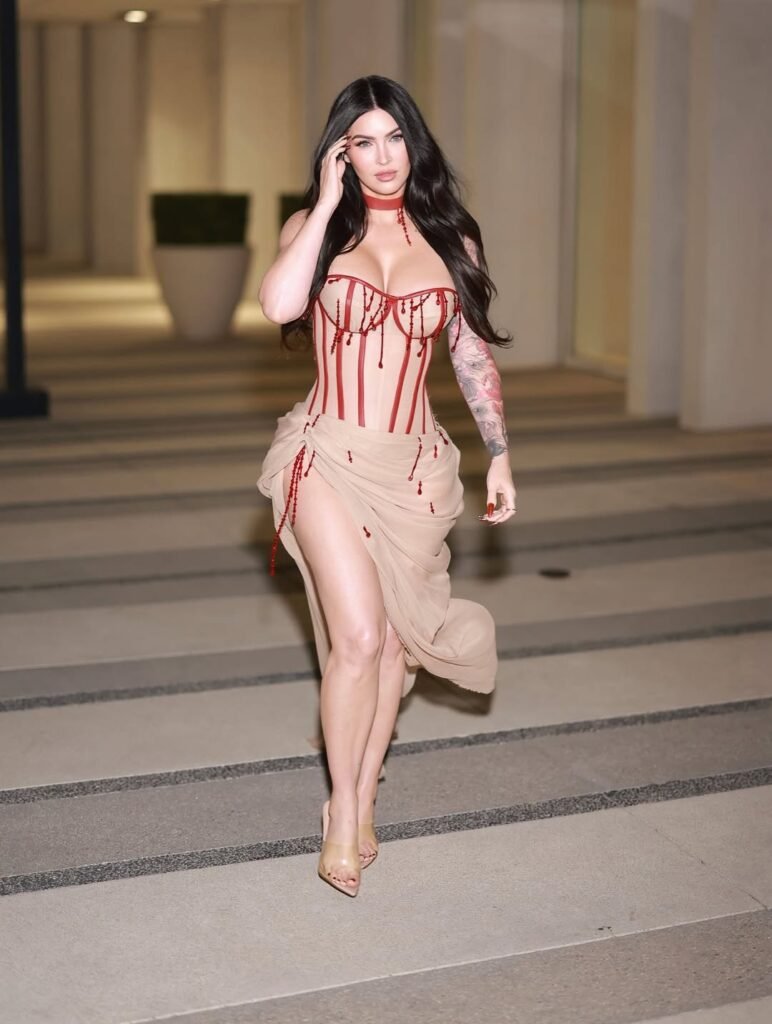There’s a moment every woman recognizes: the conscious decision to wear the thing that once defined your pain. For some, it’s the dress bought during a breakup. For others, it’s the red lipstick applied as armor before a difficult conversation. For Megan Fox, it was crystallized blood cascading down a nude corset gown. At a Los Angeles screening of Jennifer’s Body this October, Fox didn’t just reference her cult-classic horror film—she embodied its essence, wearing a custom Karine Gasparyan creation dripping with blood-red gems shaped like droplets. But this wasn’t mere thematic dressing. As Fox revealed at the event, the 2009 film marked a period when she was “really struggling,” and fifteen years later, her choice to quite literally wear that struggle on her body represents something fashion rarely captures: the visible transformation of trauma into triumph. In an era where celebrities are increasingly using their wardrobes as manifestos, Fox has mastered the art of turning pain into power, one blood drop at a time.
The psychology behind Fox’s sartorial choice extends far beyond simple costume homage. What she accomplished on that Los Angeles red carpet was a masterclass in what fashion theorists are now calling “reclamation dressing”—the deliberate act of revisiting and recontextualizing painful chapters through clothing. The custom nude corset gown, with its blood-red crystal droplets, matching red boning, and cloud-like asymmetric skirt, wasn’t just a nod to her character Jennifer Check. It was a declaration of ownership over a narrative that had, for too long, been written by others.
In 2009, when Jennifer’s Body premiered, Megan Fox was simultaneously at the peak of her visibility and the nadir of her agency. The film, written by Diablo Cody and directed by Karyn Kusama, told the story of a possessed high school student who murders male classmates—a razor-sharp commentary on female rage, objectification, and the monstrous expectations placed on beautiful women. Yet the marketing campaign sold it as a sexual fantasy for male audiences, and critics dismissed it as exploitative trash. Fox, who had poured her authentic struggle into the role, watched as both the film and her performance were reduced to the very objectification the movie sought to critique.

The intervening fifteen years have brought vindication. Jennifer’s Body has been reclaimed as a feminist horror masterpiece, its prescient themes about toxic masculinity, sexual violence, and female friendship finally recognized by a generation ready to receive its message. But Fox’s personal vindication took longer. She disappeared from Hollywood’s A-list, spoke openly about being “cast out” after refusing to play the compliant starlet, and endured years of dismissive coverage that prioritized her appearance over her talent or intelligence.
Which makes her return to Jennifer’s Body, draped in literal blood drops, all the more potent. Fashion has always been a language, but in Fox’s hands, it becomes both testimony and transformation. The corset—historically an instrument of constraint—is reimagined as a canvas for visibility. The blood, once a symbol of victimhood in the film’s narrative, now reads as evidence of survival. The nude base suggests vulnerability, but the red choker, coordinating manicure and pedicure, and clear PVC heels create a cohesive visual statement that screams intention, not accident.
Dr. Dawnn Karen, a fashion psychologist and pioneer of the field known as “Fashion Psychology,” explains that clothing choices during significant life moments serve as both armor and announcement. “When someone returns to a site of trauma or complexity, their clothing choices become a form of narrative control,” she notes. “They’re not just showing up—they’re showing up on their terms, dressed in their truth.” This concept of “narrative control” is precisely what Fox exercised. By working with designer Karine Gasparyan to create a look that was simultaneously vulnerable and fierce, referential and forward-looking, Fox took control of how her Jennifer’s Body chapter would be remembered.
The collaborative nature of the look deserves particular attention. Gasparyan, an LA-based designer who has quietly become the go-to for celebrities making bold psychological statements through fashion, documented the multi-angle creation on Instagram. This wasn’t a stylist pulling samples from a fashion house or a publicist orchestrating an image. This was two women, artist and muse, translating complex emotional territory into wearable art. The blood-drop crystals weren’t purchased—they were conceptualized, designed, and executed specifically to externalize Fox’s internal journey.

This represents a seismic shift in celebrity styling. For decades, red carpet fashion prioritized conventional beauty and designer name recognition. Celebrities were clothed, not dressed. They were mannequins for brands, not collaborators in storytelling. But the current era of method dressing—a term popularized by Zendaya’s stylist Law Roach but embodied by everyone from Lady Gaga to Florence Pugh—has transformed the red carpet into a stage for personal narrative. Clothing has become conceptual, psychological, even therapeutic.
Fox’s approach to method dressing differs from her contemporaries in its raw emotional honesty. Where others might reference their work through clever visual puns or thematic color palettes, Fox literalizes her pain. She doesn’t hint at blood—she wears it. She doesn’t suggest vulnerability—she appears nearly nude in transparent fabric and exposed boning. This refusal to soften her message, to make her reclamation palatable or pretty, is what makes it so powerful.
At the screening, Fox spoke with unexpected candor about what the film represented. “It was very healing for me during a time when I was really struggling,” she shared, adding that her lack of clarity at the time contributed to the raw authenticity of her performance. This admission reframes everything. The blood drops aren’t just costume jewelry—they’re crystallized truth. The corset isn’t just a garment—it’s the physical manifestation of constraint she’s finally shed. The entire look becomes a three-dimensional therapy session, conducted in public, for an audience that watched her struggle in real-time.

Trauma therapists increasingly recognize the power of deliberate re-engagement with painful periods. Dr. Bessel van der Kolk, author of “The Body Keeps the Score,” has written extensively about how trauma lives in the body and requires physical, not just psychological, processing. While Fox’s fashion choice isn’t clinical therapy, it operates in a similar realm—using the body, clothed intentionally, to process and release what was once overwhelming. By choosing to embody Jennifer Check again, but on her own terms, with full creative control, Fox demonstrates what trauma recovery can look like when given permission to be visible, messy, and triumphant all at once.
The timing of Fox’s appearance—ahead of Halloween weekend, fifteen years after the film’s release—adds another layer of meaning. Halloween, that liminal space where we costume ourselves as our fears and fantasies, becomes the perfect backdrop for Fox’s reclamation project. She’s not dressing as Jennifer Check for entertainment. She’s showing us what it looks like when you integrate your shadows, when you stop running from the versions of yourself that society found too much, too dark, too threatening.
This is where Fox’s styling evolution becomes a roadmap for understanding how women navigate public life under intense scrutiny. Her early 2000s red carpets showcased a young actress styled for male consumption—tight dresses, exaggerated sexuality, postures of availability. She was gorgeous, undeniably, but she was also trapped in an image created by others. Her middle period, during her Hollywood exile, showed a woman experimenting with different presentations—sometimes withdrawn, sometimes defiant, always searching. Now, in this latest chapter, we see a woman who has learned to dress for herself, to use fashion as a tool of self-definition rather than external validation.

The Gasparyan gown, with its blood-red accents and architectural construction, rejects traditional red carpet prettiness. It’s not designed to please. It’s designed to communicate. And what it communicates is complex: I survived. I remember. I’m not hiding. I’m not sanitizing my experience for your comfort. This is my truth, crystallized and worn proudly.
Fashion scholars will likely study this moment as emblematic of a broader cultural shift in how female celebrities present themselves. The era of passive beautification is ending. In its place emerges active storytelling, where clothing becomes a form of memoir, each outfit a chapter, each accessory a footnote. Fox isn’t alone in this practice—think of Billie Eilish’s deliberate anti-sexualization wardrobe, or Megan Thee Stallion’s embrace of hyperfemininity as empowerment, or Rihanna’s pregnancy fashion that refused to hide or minimize her changing body. These are women using fashion to seize control of narratives that were never theirs to begin with.
But Fox’s contribution to this evolution is particularly poignant because of what she endured. She was the cautionary tale, the woman who spoke too freely, who refused to smile through disrespect, who pushed back against objectification and paid the price. Her fifteen-year journey from ingénue to exile to self-determined artist mirrors the cultural journey we’ve all taken regarding how we treat women in public life. That she chose to mark her return to Jennifer’s Body wearing literal blood—the blood she shed, metaphorically, in making the film and surviving its aftermath—transforms fashion into justice.

The clear PVC heels deserve particular mention. Transparent, modern, slightly uncomfortable-looking, they suggest walking through pain without hiding it. They’re not the towering, flesh-toned stilettos of early 2000s red carpets, designed to elongate and objectify. They’re conceptual, avant-garde, a little bit punk. They say: I’m standing in my truth, and yes, you can see through to the foundation, and yes, it still holds me up.
As we move further into an era where authenticity is currency and vulnerability is strength, Fox’s method dressing offers a template. Reclamation doesn’t require forgetting. It doesn’t demand forgiveness or prettification or moving on. Reclamation can look like showing up to the scene of your pain dressed in its literal imagery, transformed by time and intention from wound to weapon, from shame to power.
The blood drops cascading down Megan Fox’s custom corset aren’t decorative. They’re declarative. They announce that she remembers, she survived, and she’s claiming every part of her story—the beautiful, the painful, and the blood-soaked truth of what it cost to become herself. In a world that still struggles to let women be complex, that still wants to separate the pretty from the powerful, Fox’s sartorial choices remind us that sometimes the most radical act is simply wearing your whole truth on your body and refusing to apologize for taking up space while doing it.
Method dressing, in Fox’s hands, becomes method healing. And that might be the most transformative fashion statement of all.



